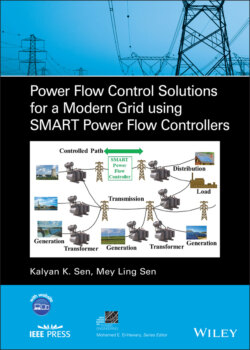Читать книгу Power Flow Control Solutions for a Modern Grid Using SMART Power Flow Controllers - Kalyan K. Sen - Страница 13
Nomenclature
ОглавлениеβRelative phase angle of the series‐compensating voltage with respect to the sending‐end voltageδsPhase angle of the voltage at the sending end of a lineδrPhase angle of the voltage at the receiving end of a lineδPower angle (difference of phase angles of the voltages at the two ends of a line)δ′Modified power angle (difference of phase angles of the voltages at the two ends of a line after compensation)δ′lLowest modified power angleδ′hHighest modified power angleεLeast error of the calculated voltage and actually‐tapped voltage in the Sen TransformerθPhase‐locked loop (PLL) angleθIPhase angle of the line currentθVXPhase angle of the voltage across the line reactanceοDegreeφPower factor angleϕPhase angle between the voltage across the line reactance and the voltage difference between the sending and receiving endsωAngular frequencyψPhase‐shift angle of the modified sending‐end voltage with respect to the sending‐end voltageΩUnit of resistance, reactance, and impedancea1‐b1‐c1Series‐compensating windings in the A phase of STa2‐b2‐c2Series‐compensating windings in the B phase of STa3‐b3‐c3Series‐compensating windings in the C phase of STA‐B‐CExciter windings of STA1‐B1‐C1Shunt‐compensating windings in the A phase of STA2‐B2‐C2Shunt‐compensating windings in the B phase of STA3‐B3‐C3Shunt‐compensating windings in the C phase of STAAmpere (unit of current)ACAlternating CurrentANSIAmerican National Standards InstituteaprInstantaneous apparent power ratingAPRApparent Power RatingATCAvailable Transfer CapabilitybMultiplier of VXn from 0 to 1BPSBulk Power SystemBTB‐SSSCBack‐To‐Back SSSCBTB‐STATCOMBack‐To‐Back STATCOMBYPBRKBypass breakerCCapacitancecos(φ)Power factorcpCompensating points of the Sen TransformerCSCConvertible Static Compensatorcr, cs′, cseInterceptdDuty cycleDCDirect CurrentDCLSDC Link SwitchEShunt‐ or series‐connected voltageEHVExtra High VoltageESElectronic SwitchFFarad (unit of capacitance)FACTSFlexible Alternating Current Transmission SystemsFCFixed CapacitorGaNGallium NitrideGHGGreen‐House GasGPFCGeneralized Power Flow ControllerGSTGeneralized Sen TransformerGTOGate‐Turn OffHHenry (unit of inductance)HVHigh VoltageHzHertz (unit of frequency)iInstantaneous current, such as line current (i), exciting current (iex), sending‐end current (is), source current (isrc), and so onILine current magnitudeILine currentIBRInverter‐Based ResourceIECInternational Electrotechnical CommissionIEEEInstitute of Electrical and Electronics EngineersIexExciter current through the primary winding of the Sen TransformerIPFCInterline Power Flow ControllerInNatural line current magnitudeIRImpedance RegulatorIsCurrent at the sending end of the lineIsrcSource currentITCRCurrent through Thyristor‐Controlled ReactorkNumber of TCSC sectionskHzKilo Hertz (unit of frequency)kRFactor, representing the ratio of line resistance, R, when line current is I and the line resistance, Rn, when line current is In.LInductanceLTCLoad Tap ChangerLVLow VoltageMCMagnetic Circuitmr, ms′, mseSlopemsMillisecondMSTMultiline Sen TransformerMvarMega VAR (unit of reactive power)n(subscript) NaturalNCNormally‐ClosedNERCNorth American Electric Reliability CorporationNONormally‐OpenpThree‐phase instantaneous active powerPActive powerPARPhase Angle RegulatorPlinenPower loss in the natural or uncompensated linePlinkActive power on the common linkPrActive power at the receiving end of the linePrhHighest active power at the receiving end of the linePrlLowest active power at the receiving end of the linePrnNatural active power at the receiving end of the linePsActive power at the sending end of the linePseExchanged active power by a Series UnitPshExchanged active power by a Shunt UnitPsnNatural active power at the sending end of the linePsrcActive power at the sourcePs′Active power at the modified sending end of the linePFCPower Flow ControllerPOCPoint of Connection to the utilityPSTPhase‐Shifting TransformerpuPer unitqThree‐phase instantaneous quadrature powerQQuality factorQReactive powerQBQuadrature BoosterQlinenReactive power absorbed by the natural or uncompensated lineQlinkReactive power on the common linkQrReactive power at the receiving end of the lineQrhHighest reactive power at the receiving end of the lineQrlLowest reactive power at the receiving end of the lineQrnNatural reactive power at the receiving end of the lineQsReactive power at the sending end of the lineQseExchanged reactive power by a Series UnitQshExchanged reactive power by a Shunt UnitQsnNatural reactive power at the sending end of the lineQsrcReactive power at the sourceQs′Reactive power at the modified sending end of the linerkVoltage error at a possible kth operating point in the Sen TransformerRLine resistanceR′Resistance of a section of a lineReffEffective line resistanceROMRough‐Order MagnitudeRMSRoot Mean SquareRRReactance RegulatorRseSeries‐compensating resistanceRshShunt‐compensating resistancesSecondSApparent powerSiCSilicon CarbideSMARTSpecific, Measurable, Attainable, Relevant, and Time‐boundSPFCSMART Power Flow ControllerSrApparent power at the receiving end of the lineSsApparent power at the sending end of the line se(subscript) Series‐exchanged, i.e. cse, mse, Pse, Rse, Xse , Qse, ZseSseExchanged apparent power by a Series Unit sh(subscript) Shunt‐exchanged, i.e. Psh, Rsh, Xsh , Qsh, ZshSshExchanged apparent power by a Shunt UnitSSSCStatic Synchronous Series CompensatorSs′Apparent power at the modified sending end of the lineSTSen TransformerSTATCOMSTATic synchronous COMpensatorSVCStatic Var CompensatorSynConSynchronous CondensertTimeTCRThyristor‐Controlled ReactorTHDTotal Harmonic DistortionTNATransients Network AnalyzerTSCThyristor‐Switched CapacitorTSRThyristor‐Switched ReactorTTCTransmission Transfer CapabilityUHVUltra High VoltageUPFCUnified Power Flow ControllerUPSUninterruptible Power SupplyvInstantaneous voltageVPhase voltage magnitudeVPhasor voltageVVolt (unit of voltage)vavolt‐ampere (unit of instantaneous apparent power)VAVolt‐Ampere (unit of apparent power)VARVolt‐Ampere Reactive (unit of reactive power)VRVoltage RegulatorVRTVoltage‐Regulating TransformerVSCVoltage‐Sourced ConverterVdVoltage across the compensating resistanceVdqVoltage across the compensating impedanceVqVoltage across the compensating reactanceVrVoltage at the receiving end of the lineVsVoltage at the sending end of the lineVs′Voltage at the modified sending end of the lineVs′hHighest voltage at the modified sending end of the lineVs′lLowest voltage at the modified sending end of the lineVs′sSeries‐compensating voltageVRVoltage across the line resistanceVRnNatural voltage across the line resistanceVR,XVoltage across the line impedance VRn,XnNatural voltage across the line impedance VXVoltage across the line reactanceVXnNatural voltage across the line reactanceWWatt (unit of active power)WECCWestern Electricity Coordinating CouncilXLine reactance (total)X′CCapacitive reactance of a section of a lineXeffEffective line reactanceX′LInductive reactance of a section of a lineXseSeries‐compensating reactanceXshShunt‐compensating reactanceZseSeries‐compensating impedanceZshShunt‐compensating impedance
